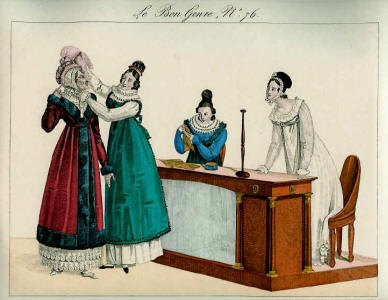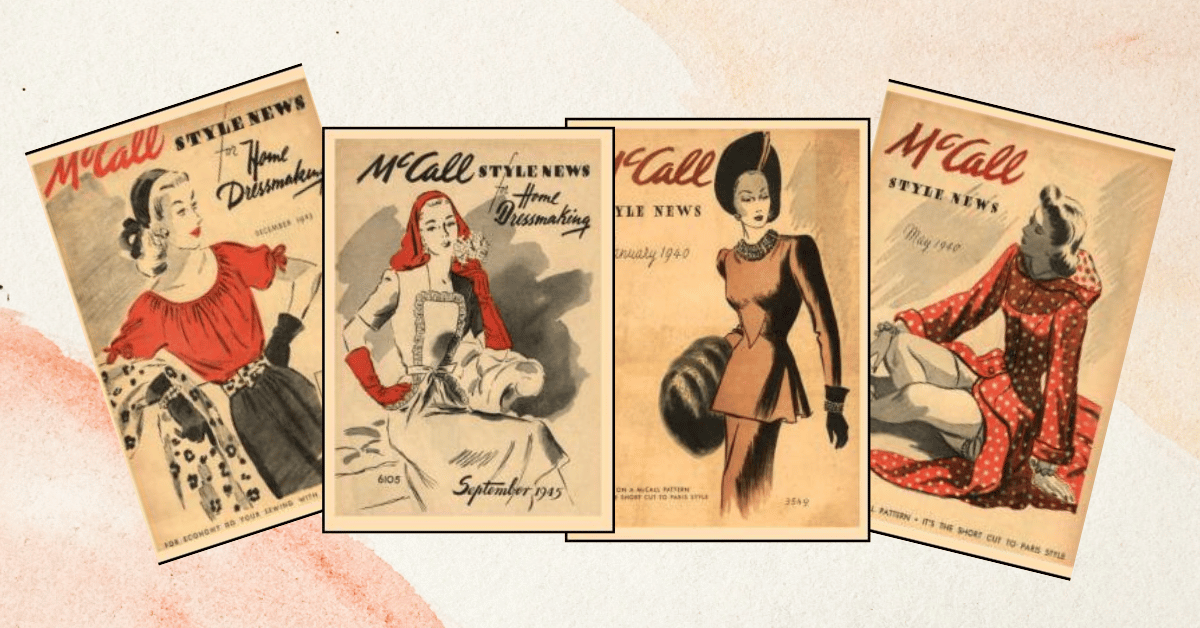By Pauline Weston Thomas for Fashion-Era.com
Table of content
- Meaning of Costume Plate and Fashion Plates
- Early Costume Plates
- Le Monument du Costume
- La Gallerie des Modes
- Heideloff's Gallery of Fashion
- The World of Fashion
- Portraits
- When Did Fashion Plates Start?
- Hand Coloured Engraving 1831 La Belle Assemblée
- La Belle Assemblée
- Ackermann's Repository of Arts
Is it a Costume Plate or a Fashion Plate?
There is a difference between a fashion plate and a costume plate. Costume plates show costume as it was worn in the past, especially everyday past fashions.
Fashion plates promote and publicize possible future fashions. Costume plates are about the fashions of the past and fashion plates are about fashion ideas now or the near future. Costume plates almost always include national, theatrical, court and royal dress.
Masks and disguises were used for masquerades, carnivals and fancy dress parties especially in times of less liberal attitudes enabling people to let their hair down. Plates often featured dresses for these occasions. So some pictorial examples are misleading. At the bottom of the is a misleading costume plate against a fashion plate. One is a true fashion of the day and the other is a costume selection of dress from a previous era or a depiction of European regional dress.
Fashion plates really reached their peak in the 19th century when they were hand-coloured engravings. Early costume plates are often black and white engravings and were almost always of men not women.
Early Costume Plates
Albrecht Dürer made the first costume plates in 1494 when he made a record of clothing styles typical of national and regional dress of Nuremburg and Vienna These were the first costume engravings of dress already worn in the past. Later in 1640, Wenceslas Hollar a very talented Polish engraver when working in England, produced 26 costume plates showing day dress of the typical English middle classes. He went on to make some 2740 plates on various subjects including European costume and accessories.
Le Monument du Costume
Of the generations of the famous C17th Bonnart family of engravers, Nicolas Bonnart (the elder) is famed for male and female costume plates and the family still produced plates into the 1730s. Between 1775 and 1783 some 36 costume history prints we now know under the short title of Le Monument du Costume were made. They were not fashion plates, but are the best known plates of the era and have been reprinted many times. They also showed new elements of detail that led to the fashion plate of the C19th.
356 other very pretty mostly hand coloured fashion plates were also produced by competitors such as Cabinet des Modes that ran from 1785 to 1789.
La Gallerie des Modes
In 1778 Jacques Esnauts and Michel Rapilly of Paris joined forces and began to issue their La Gallerie des Modes publication of coloured fashion plates. Between 1778 and 1787 they in total, issued some 342 figure plates and some 72 hat plates, all published at spasmodic intervals. This work is exceptionally scarce in original form even among museum collections, with the main (incomplete) copy of the collection held at the Bibliothèque Nationale in Paris.
Fortunately for we costume lovers 325 of the figure fashion plates were reproduced by Émile Lévy in Paris between 1911 and 1914 and they were also hand coloured. Even the Lévy reproduction issue became valuable.
There is a copy of the Lévy reproduction Gallerie des Modes in the Victoria and Albert, London Museum.
Heideloff's Gallery of Fashion
The next lot of famous costume plates were after 1794 by Nicolaus Wilhelm von Heideloff. Heideloff was a painter of miniatures, he found himself out of work after the French Revolution.
He next sought work in London where he initially found employment at R. Ackermann the publisher of fine prints and book seller. Next he left to work alone and soon issued his own Gallery of Fashion, promising that it would contain accurate copies of styles worn by ladies of rank and fashion.
Heideloff issued this monthly Gallery of Fashion and each issue contained 2 lovingly hand coloured aquatints finished with gold, silver or other metallic paints.

Heideloff issued in total 217 Georgian fashion plates between 1794 and 1803 showing 362 different figures.
They are great examples of the Directoire era. The figures are shown in many activities almost always out of doors and accessories always complete the picture. There is wonderful set of Heideloff's Gallery of Fashion held at the Victoria and Albert Museum and the image below is from a Heideloff fashion plate from 1796.
Costume plates may be commissioned to show for example all the kings and queens of a nation over the years or regional dress of a country.
In particular, costume plates often show occupational everyday dress as has been typically worn.
Some plates such as these below may even give a version that would be seen as an idea for fancy dress costume. This plate below from 1839 does just this as it captures 'elements' of dress from a previous era and as such can be totally misleading.
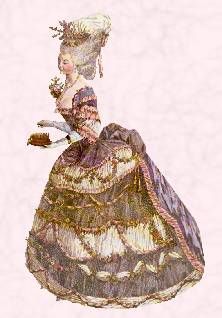
I include these 2 references to an early C19th costume book Le Bon Genre and The World of Fashion magazine on this early page as it has neat examples explaining differences in costume and fashion plates and satirical takes on fashion.
Le Bon Genre - Satirical Review
Le Bon Genre was a costume book first published in 1817. It's worth recalling that there had been hostilities between France and England for years. Despite the Battle of Waterloo and the resolving of ongoing indifferences the Parisian French took every opportunity to ridicule English fashions even after the cessation of war. This plate below is an example of a caricature piece of an old outmoded 'English' hag choosing headwear that would obviously do nothing to enhance her whatever her final choice.
Another important book of costume published at much the same time between 1814 and 1822 was Horace Vernet's Almanach des Modes. This latter book also showed oddities of fashion a year after their adoption. It is famous for the inclusion of plates on both Merveilleuses and Incroyables which ridiculed the extravagant fashions of youth.
The World of Fashion
The World of Fashion began in 1824 and was very much an important London Regency publication with fashion plates showing up to six figures. Later World of Fashion plates are often inferior copies of work by Héloïse Leloir (one the 3 Colin sisters), but more of The World of Fashion plates are in existence in UK than those from rarer magazines. The best plates were from the early days and done by the engraver W. Alais.
One interesting point about World of Fashion plates is that they often contained up to six figures (most others had a maximum of two figures). Pages were often split to show the headwear or hair style or upper detail of a bodice. These images below are quite delightful and not as crudely coloured as some I have seen.
One is a true fashion of the day and the other a costume selection of dress from a previous era or a depiction of European regional dress. The far left dress reminds me of the type of regional Spanish dress one sees on holiday in places like Mallorca or the Canary Islands.
The World of Fashion 1839

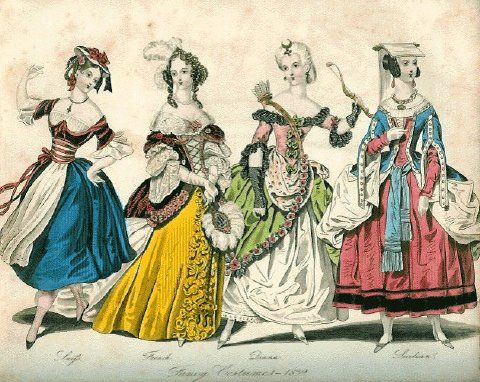
Both these early Victorian images are from a copy of 'The World of Fashion' issued in March 1839. However the plate left of 4 women gives an artist's version of earlier costume, whereas the plate right is a true fashion plate and depicts suggested fashion styles for women to follow for 1839.
These images are courtesy of UK EBay antiquarian print and engraving seller known as Cabrio4. You can buy attractive fashion plates from Cabrio4 with confidence. Her fairly priced fashion plates are frequently accompanied by descriptive text.
©Copyright Fashion-era.com 2005 - These images should not be reproduced in printed book form matter, as greetings cards, gift wrap etc., or as part of any electronic material such as a CD, DVD, TV videos, ebooks, websites or similar item.
Fashion Plate Portraits
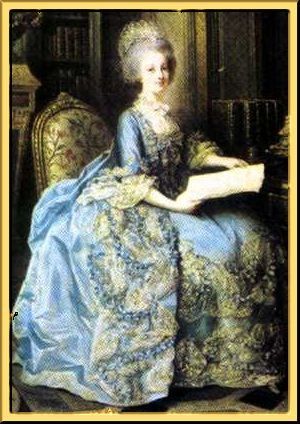
It is worth mentioning that portraits have also been used to record costume. Of course portraits of well dressed women compared to toiling women of the past, were probably of ladies, wearing fashionable contemporary dress of the day, probably their best dress.
But it's also true to note that artists would also deliberately dress their sitters in gowns of another era or in fantasy gowns or have them wear a gown half open with the sitter showing vast amounts of shoulder, totally unlike the true manner of wearing an item and all in the name of artistic excellence.
See la mode illustration.
©Copyright Fashion-era.com 2005-2032 These images should not be reproduced in printed book form matter, as greetings cards, gift wrap etc., or as part of any electronic material such as a CD, DVD, TV videos, ebooks, websites or similar item.
This Fashion Plates Page Added 8 Oct 2005
Antique Fashion Plates - La Belle Assemblée & Ackermann's
When Did Fashion Plates Start?
According to the late James Laver, fashion plates hardly existed before the French Revolution which was in 1789. With their hand colouring they almost belong to the 19th century, for after 1900 most fashion plates were produced mechanically. At the end of the 1880s, experimental colour printing had begun and the chromo-lithograph became the colour method of choice for the new century with just a few magazines retaining hand colouring. In the main, fashion plates after 1900 did not have hand colouring features.
Fashion plates as hand coloured engravings really began in England with the publication of an English monthly magazine called The Lady's Magazine in 1770. The publishers did not tint the plates in each Lady’s Magazine issue in the early days, but dressmakers did this themselves so by about 1790 they were sold touched with colour. Before that, coloured versions were simply tinted by enthusiasts at home. Fashion plates from The Lady's Magazine run until 1837.
A range of other magazines with fashion plates from England, France and Germany all ran in this era and included the following Cabinet des Modes 1785-89 and Journal de la Mode et du Goût 1790-93.
La Belle Assemblée of 1806 was one of the earliest and most influential of journals including fashion information along with The Lady's Monthly Museum which began some years earlier in 1798.
Another magazine Le Beau Monde also began in 1806 as a very obvious rival to that of La Belle Assemblée which had first published about 8 months earlier.
Le Beau Monde
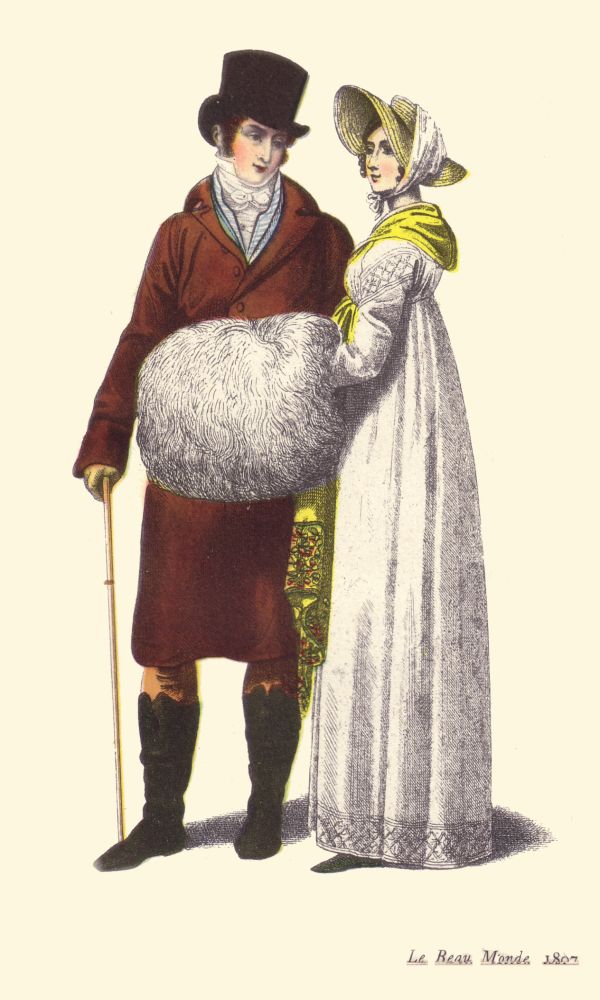
Other very pretty plates were also produced by competitors such as the Journal des Dames et des Modes with inner fashion plates entitled Costumes Parisiennes. This ran from 1797 to 1839.
All of these magazines related to female interest and were issued either monthly, fortnightly or weekly. Each contained engraved or lithograph plates beautifully hand coloured and typically the artwork was protected with tissue paper.
A breakdown of the 1807 walking dress: An elegant walking dress, is a straw gypsy hat, tied down with white silk or a rich half-lace handkerchief; a muslin gown, ornamented with knotted work crossing the shoulder to correspond with the bottom of the dress.
The body is made quite plain to draw round the bosom, and fulled in the back to imitate the frock waist, with a light yellow sarsnet or camel-hair scarf, richly diapered at the ends with various colours; the scarf is worn so that the dress may be exposed, tastefully tied with a careless knot in front.
Lilac gloves and half boots made of kid, a beautiful white down muff, adds much to the elegance and splendor of this much admired Walking Spring Dress.
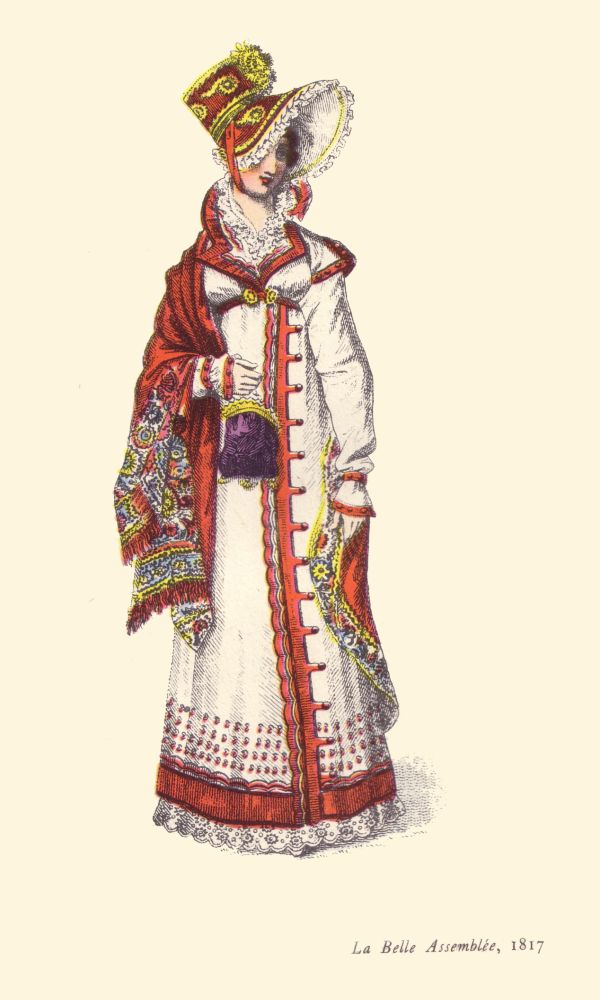
To the left: Pelisse of the Cachemire manufacture; the ground white, ornamented with a fine vermillion red.
Bonnet of vermillion coloured satin, embossed with straw, ornamented slightly with straw-coloured ribbands, and surmounted by a bouquet formed of a full blown damask rose and buds, with cars of ripe corn.
This ornament is partially placed on one side: the edge of the bonnet finished by blond laid on strait. This elegant pelisse is confined by a vermillion-coloured belt, with a gold and Ceylon ruby broach, or clasp.
Lyonese shawl with a rich border of various colours, is often thrown over this dress, as represented in the Print.
White kid half boots; Limerick gloves, and vermillion-coloured satin ridicule with gold tassels and spring. Fichu frilled with fine lace, and left open at the throat.
Dress of Urlings patent lace over a slip of lilac coloured satin. Three French tucks of white satin, falling one over the other, are placed at the edge of the border.
These are surmounted by a rich festoon trimming of white crape, consisting of full puffings; each festoon headed by an Asiatic diadem, divided by pearls, which gives a most splendid effect to this truly novel and unique kind of trimming.
The body and sleeves are elegantly simple, the former having only a slight ornament of fine lace round the bust, with a few puffs of lilac satin; the sleeves are very short, not full, and are bound tight round the arm with a broad band of satin. The head dress is à la Grecque. with two beautiful white ostrich feathers, falling over the left side.
Two rows of large pearls form the necklace worn with this dress, with a Maltese cross, of topazes. A scarf, or drapery of the same material as the dress, only of a rich pattern and not plain like the robe, is a charming addition to this elegant costume, the effect of which we have shown in our engraving.

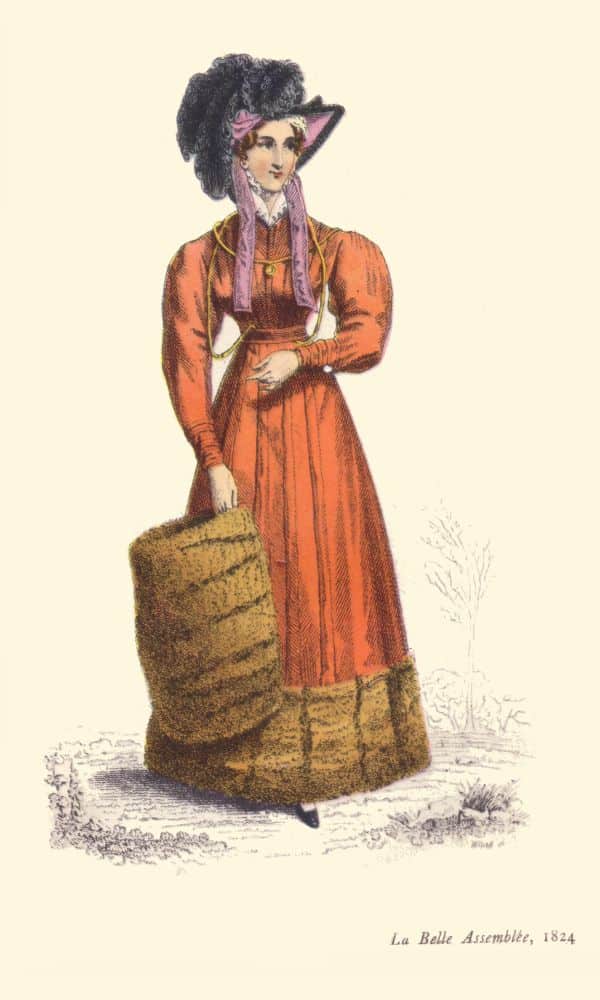
Pelisse of gros de Naples of Egyptian red, ornamented on each side of the bust, and of the skirt, with full rouleaux of the same material. A broad border of light coloured Zibeline fur surrounds the bottom of the pelisse, and a muff of the same costly skin is worn with this dress.
The sleeves of the pelisse are made en gigot, and confined half way up the small of the arm, with straps of gros de Naples, The collar stands up in the former French style, and is surmounted by a frill of lace, rather narrow.
A bonnet of black velvet, lined with pink, and tied with broad striped ribbon to correspond, is ornamented with long, drooping black feathers: underneath is worn a lace cornette, with a full ornament on one side of pink satin: the strings of the bonnet are generally left loose.
A handsome gold chain is thrown over the neck, with an eye glass tucked under the belt; and the other part of the chain is placed on the bust like a necklace; in the centre of which is a splendid bijou, as a souvenir. Black satin slippers, and lemon coloured kid gloves, complete this costume.
Dinner Dress
A dress composed of gros de Chine; the colour, a new and singularly beautiful shade of yellow. The corsage is1plain behind, and disposed in crossed drapery in front; it is cut something higher than usual, and displays very little of the chemisette, which is of blond lace.
Béret sleeves of moderate width, and very short, with long sleeves, à la Reine, over them, composed of white gaze de Soie, and terminated by a ruche of blond net. The head-dress is a toque composed of a very dark violet crape.
A bouquet of white ostrich feathers, with a knot of ribbon at its base, is placed under the brim on the left side, and two larger feathers attached to the right side of the crown droop to the left over the brim.
The jewelry should be of burnished gold.
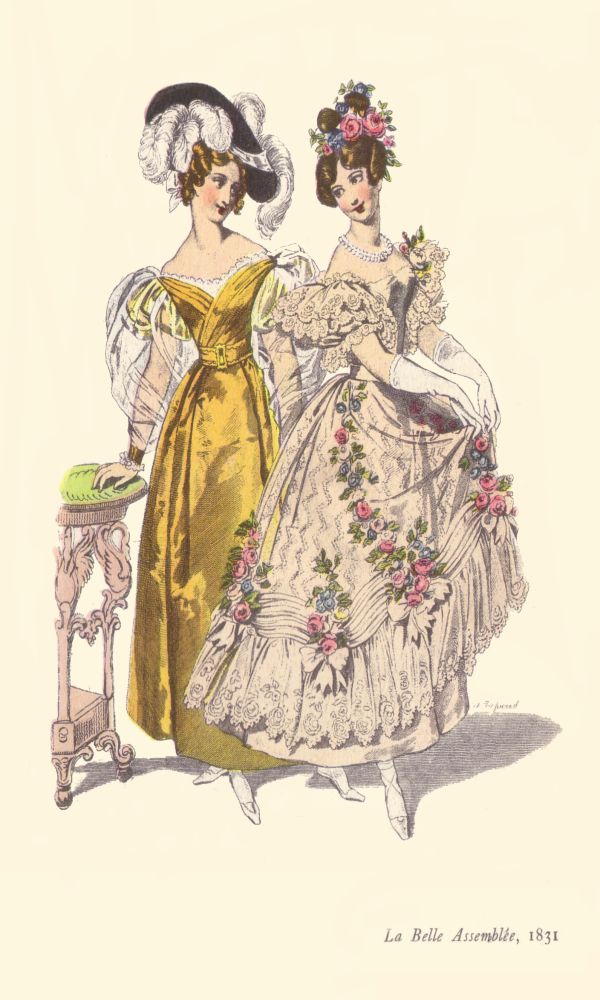
Ball Dress. A dress of white satin striped gauze, over a white gros de Naples slip. Corsage à la Grecque, with béret sleeves, surmounted by a double fall of blond lace disposed en mancheron. The skirt is trimmed with a deep flounce of blond lace, above which is a trimming of plain gauze arranged in bouillons, by bouquets of roses and bluebells, which are attached to the dress by knots of white gauze ribbon.
A wreath of these flowers ascends from a bouquet on each side of the front of the skirt to the waist, en tablier. The hair is dressed in full curls on the forehead, and in bows of moderate height on the summit of the head. A chaperon of roses and bluebells surrounds the base of the bows. Necklace and car-rings pearls.
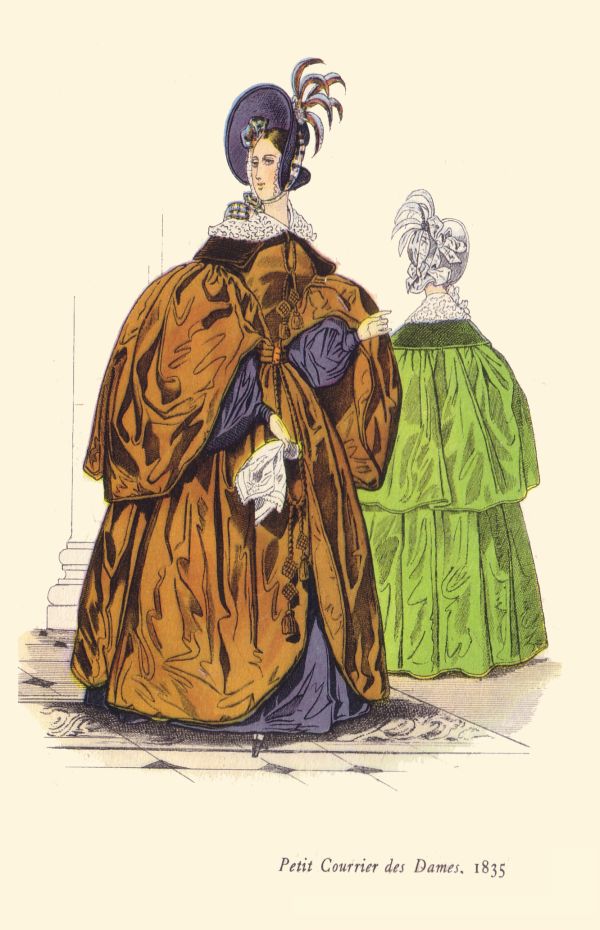
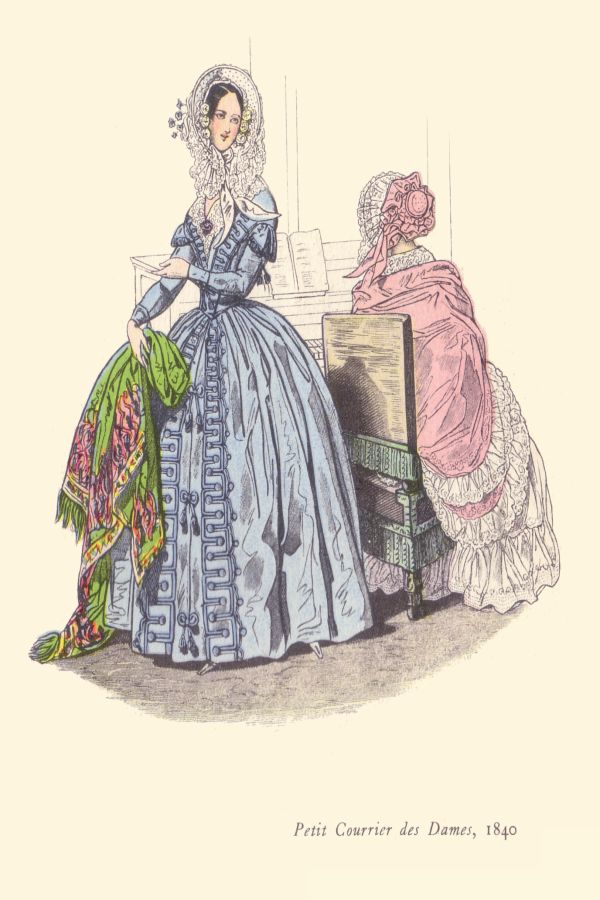
Top left: Satin mantle with wide cape-sleeves to allow room for the leg of-mutton sleeves 617 the dress. High poke-bonnet trimmed with cock's feathers and a checker-pattern ribbon.
Top right: The seated lady wears a robe of embroidered muslin. Her shawl is of gros de Naples garnished with lace. The other dress is decorated with braid, and the shawl has a printed pattern. The hats are of muslin garnished with lace.
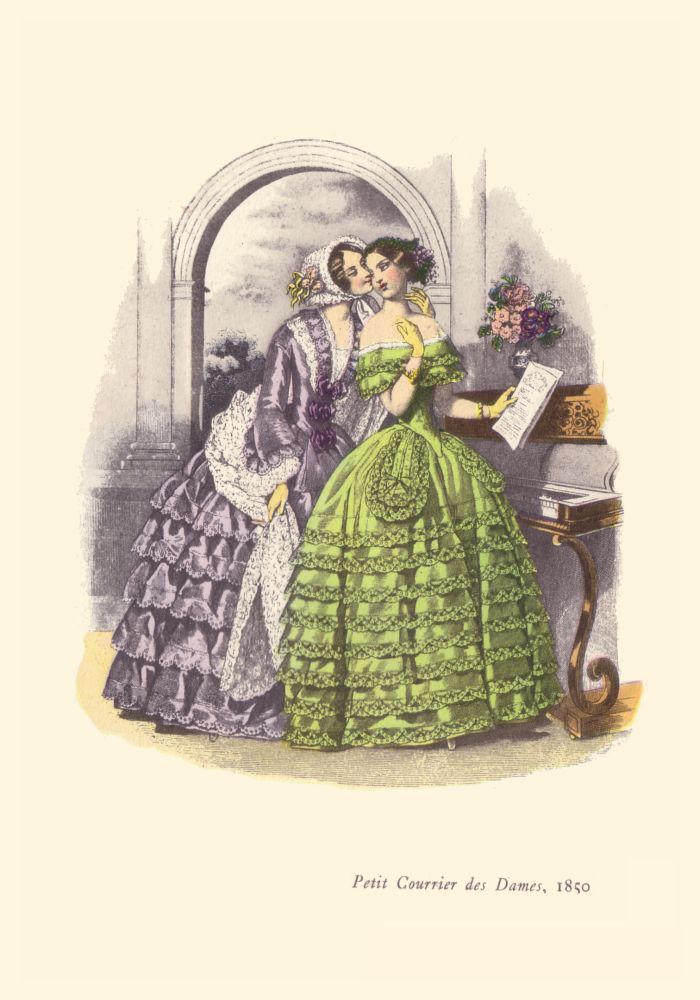
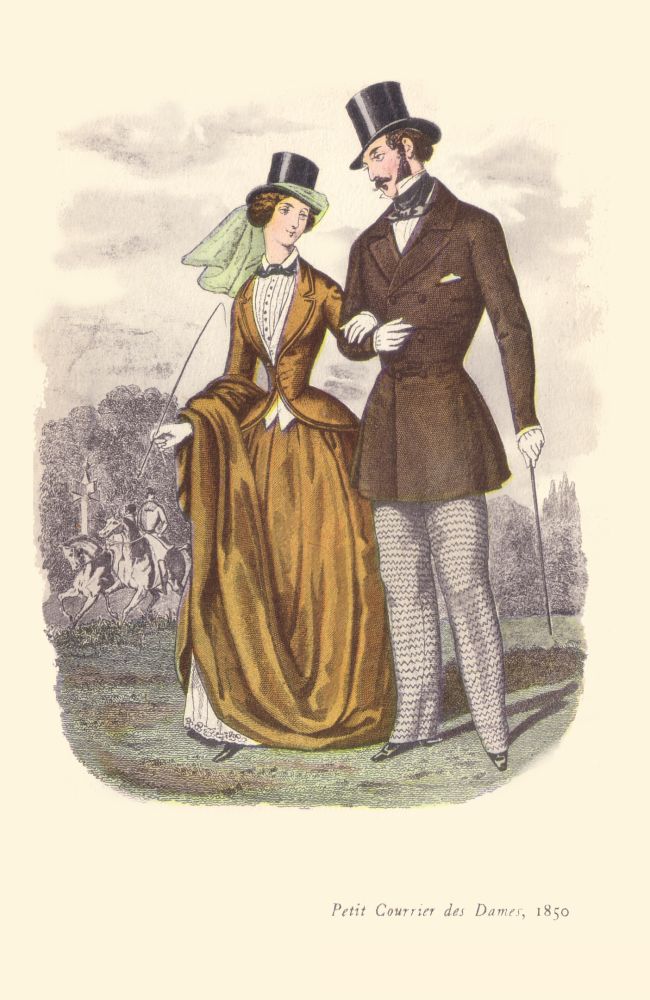
Top left: Day dress and evening dress in tulle and grenadine, trimmed with ribbons. Shawl of white lace. Lace bonnet trimmed with ribbons.
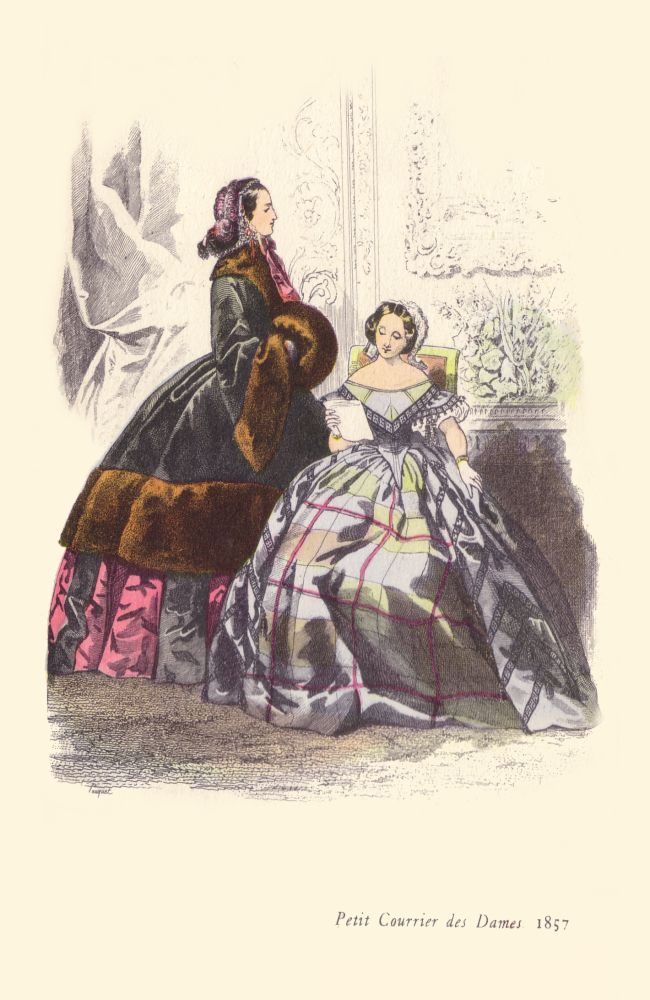
Outdoor dress in gooseberry green and black taffeta with wide stripes. Casaque in velvet garnished with zibeline.
Hat of green velvet. Concert dress in antique Scotch moiré, satin trimmings, blue Louise, jade passementerie ornamented with ball-fringe; low-necked corsage with berthe in moiré, ornamented with the same passementerie, short sleeves ornamented with the same, a knot of which is placed at the side and falls over the arm.
Head-dress in blue velvet with twisted and tinted plumes.
Toilette de Ville with three flounces and a panier bustle dixhuitème siècle; a broad horizontal band of velvet encircles the skirt; short pagoda sleeves. Small hat trimmed with ribbons, flowers and feathers. jacket trimmed with narrow bands of fur; bonnet trimmed with feathers; muff to match the jacket.

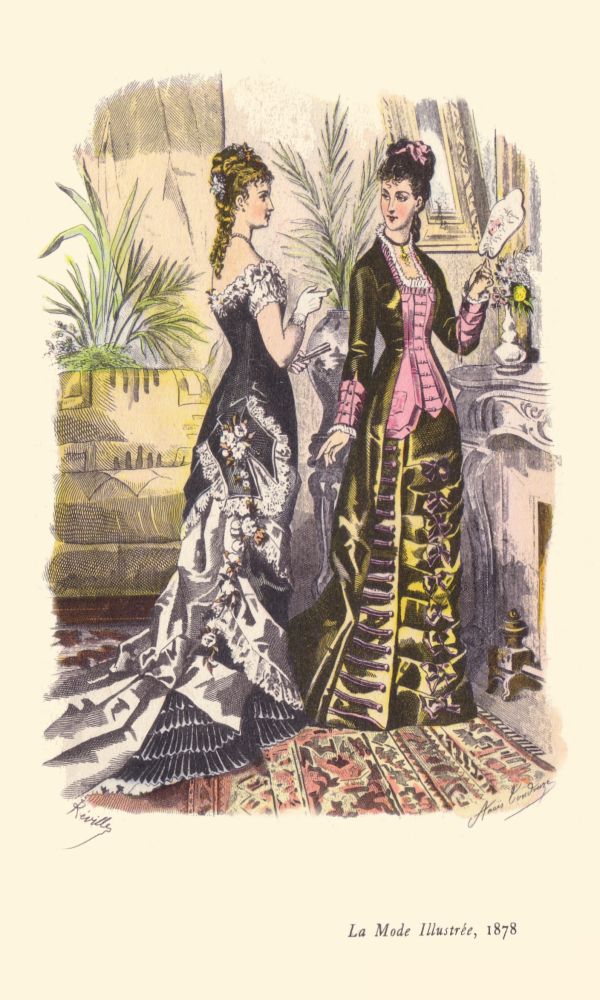
A ball toilette of satin black and moon colour (pearl grey). The edge of the skirt is trimmed with plaited flounces of black satin lined with moon satin. At the front, draperies of moon satin and black satin.
At the back a train of the moon satin. The draperies of the moon satin are trimmed with white lace. At the side a string of white roses. Round the neck of the low body is a string of white roses instead of a berthe. Short sleeves of white smooth crape puffed.
A dinner toilette. Of bronze satin and pink faye. The skirt is trimmed with large horizontal plaits; in the middle on each plait is a bow of the same satin double-faced bronze and pink.
On each side of these plaits, a very large reverse striped with very long button-holes of pink faye terminated with a pink button. A great pink faye waistcoat, opened in a square shape. Long sleeves; very high reverses of pink faye.
An out of doors toilet of dark-blue satin merveilleux and a damasked tissue the ground of the same colour. The round skirt made of the satin material, is trimmed with a bouillonné and a plaited flounce.
This trimming is twice repeated.
The tunic is of the damassé tissue, horizontally plaited in front and raised in poufs behind. The basque of the corsage is disposed in paniers and trimmed with a fringe to match the damassé tissue. The draperies are raised by the means of macarons of braiding to match the fringe.
A costume for hunting for a young woman or a young girl. The costume, made of chamois colour cloth, middling tints, is composed of a short skirt plaited perpendicularly.
Under its nether edge is a narrow plaited flounce made of surah of the caroubier shade.

The tunic of the same cloth, a little shorter than the skirt, piped in red surah, is slit at the front and widely raised at the hips, so as to show all the front of the skirt. A veste justaucorps of the same cloth, very long, piped in red, with red buttons, the neck gears three collars of unequal size piped the same. An upright linen collar and manchettes to match. A red cravate (sic). A game-bag (gibecière) made of Russian leather. A toque of chamois felt trimmed with pheasant feathers. Yellow leather boots, very high.
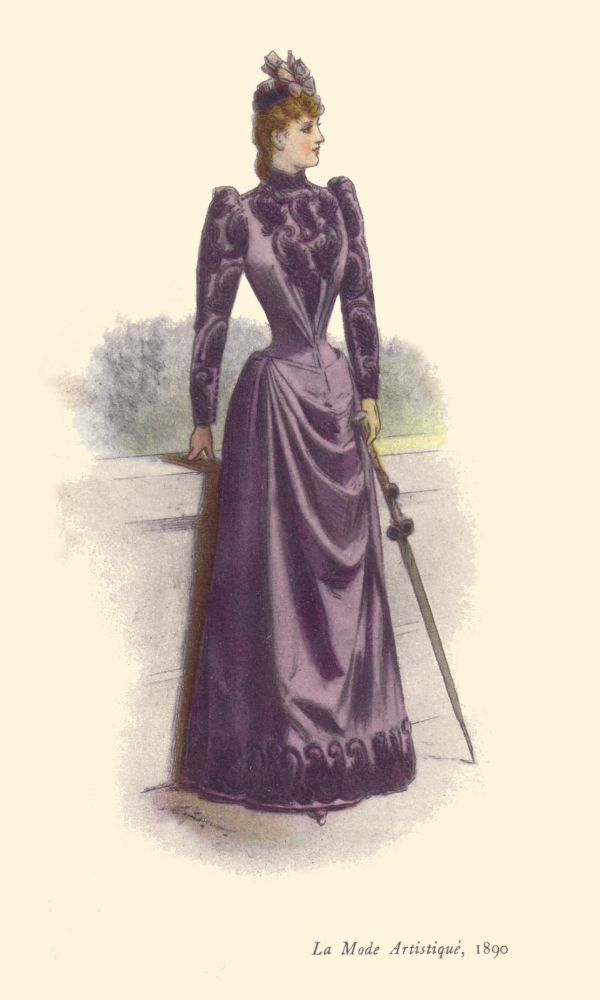
Silk reps or corded silk in a lovely shade of heliotrope adorned with black passementerie of elaborate design. The round skirt cut longish, is trimmed with passementerie.
The front is caught up on either hip so that the material should form a few natural folds as shown.
The skirt is mounted on the extremity of the bodice. This is hooked on the shoulder and under the arm, and is adorned with passementerie describing a plastron descending in a point to the bend of the waist, between the folds of the bodice.
The sleeves entirely covered with passementerie are slightly gathered at the shoulder while they are close-fitting at the bottom and are fastened with a closely set row of small black buttons.
Small capote of velvet to match the gown adorned with knots of green and mauve ribbons. Black kid shoes; short kid gloves.
FOOTNOTE
The words are as shown in the original text, much of which was taken from the original fashion plate information. These words must have been unusual and different enough or then thought so foreign so they were highlighted. The spelling of Cachemire is French which somehow must have made it seem even more novel than kashmir or kerseymere or cashmere.
LIST OF PLATES
LE BEAU MONDF, 1807, LA BELLE ASSEMBLÉE I8I7, LA BELLE ASSEMBLÉE 1823, LA BELLE ASSEMBLÉE, 1824, LA BELLE ASSEMBLÉE 1831, PETIT COURRIFR DES DAMES, 1835, PETIT COURRIER DES DAMES, 1840 PETIT COURRIER DES DAMES, 1840, PETIT COURRIER DES DAMES, 1850, PETIT COURRIER DES DAMES, 1850, PETIT COURRIER DES DAMES, 1857, GAZETTE OF FASHION, 1861, THE YOUNG ENGLISHWOMAN, 1871, LA MODE ILLUSTRÉE, 1878, LA MODE ILLUSTRÉE, 1880, LA MODE ARTISTIQUE, 1890.
La Belle Assemblée
This important magazine had a 63 year run, although it did change ownership in that time. La Belle Assemblée contained not only hand-coloured fashion plates, but also sheet music and articles of general interest so it had broader appeal than just fashion.
In his authoritative book, Hand Coloured Fashion Plates 1770-1899, Vyvyan Holland comments that the production of the fashion plates of this magazine La Belle Assemblée falls into five natural periods, beginning with the conventional crudely coloured first period of 1806-1809. This era for plates was made worse by the lack of colour in clothing, since white gowns were mostly in fashion then.
The second period 1809-1820 was much improved, with even greater improvement in the third period from 1821 to 1832 and this last period is the one I personally collect.
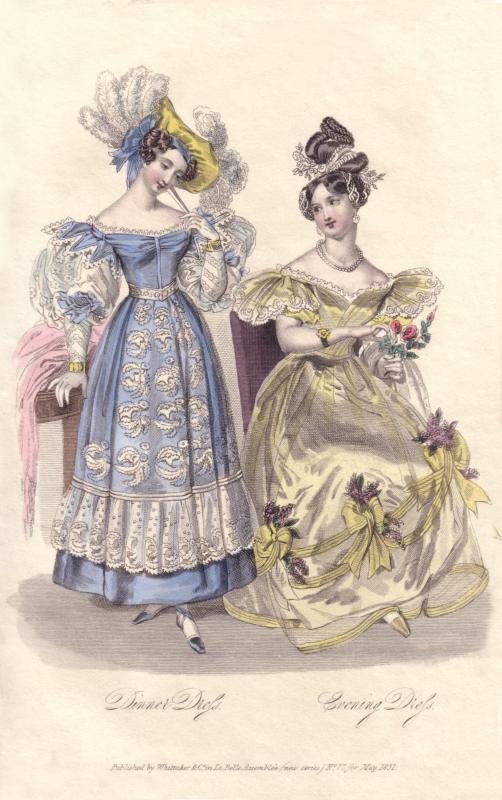
The 1831 engraved fashion plate below is one of these superior engravings. It is so dainty and elegant. It has wonderful colour and the 150 word description of the yellow evening dress refers to it as a 'dress of canary coloured gaze Clementine over satin......' The engraving is so well done you can almost touch the shimmering light attracting satin fabric folds and the shadows of the gauze overskirt. This is the quality associated with La Belle Assemblée.
Hand Coloured Engraving 1831 La Belle Assemblée
This hand coloured engraving is from a William IVth fashion periodical called La Belle Assemblée.
It came complete with a fashion description text of fabrics and styles of the greatest detail for May 1831. This was a joy to read as descriptive text is so often missing.
At 24cm by 15cm, La Belle Assemblée is often much smaller than people expect when they first buy original prints. That's because at about 9" tall the pages were intended to be held for reading. However, the smallness means the engravings have a delicacy and daintiness, making them even more attractive to collectors.
Sometimes the small plates show four figures. This one just below is one of my La Belle Assemblée plates with a group of figures. The colour on this plate is brilliant and intense. I confess that my prime interest in such plates is not purely academic as you might think. I enjoy using them grouped as sets in rooms and other women like them as exquisite unusual gifts.
However when you look at a picture daily be sure it is one that has attractive elements and is finely executed. I never cease to be amazed how many visitors peer with interest at the fine details and delicacy of such pieces.
La Belle Assemblée.
This 24cm by 15cm La Belle Assemblée fashion plate has several lovely gowns including 2 court dresses on the far left and the green walking dress and the blue carriage dress. Again the hairstyle details from the romantic 1830s are perfect. The smallness of the plate makes it zing with quality as it is so finely worked and tinted. This image came with text making it doubly interesting to a collector.
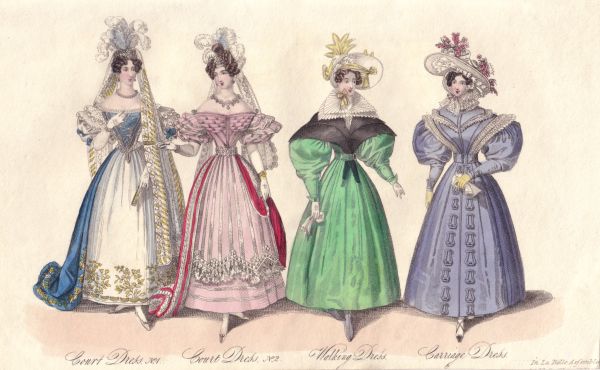
©Copyright Fashion-era.com 2023 - These images should not be reproduced in printed book form matter, as greetings cards, gift wrap etc., or as part of any electronic material such as a CD, DVD, TV videos, ebooks, websites or similar item.
But it is the fourth period of fashion plate making for La Belle Assemblée that began after 1832 and lasted until 1854 that produced many plates which were inferior copies of French plates.
Holland implies that the best period for these plates is between 1820 and 1832 and also between 1854 and 1869 when it produced delightful plates with many by Héloïse Leloir sister of Anaïs Toudouze. La Belle Assemblée was discontinued in 1869.
Now many of these magazine plates are much rarer than when Holland first examined the 5 periods some 50 years ago and so all plates from La Belle Assemblée have become very collectible.
The full name of La Belle Assemblée which was owned by John Bell, was Bell's Court and Fashionable Magazine Addressed Particularly to the Ladies. Even now, it is considered a mine of fascinating information about the literary and artistic world of the era, plus other contents of hints and tips to achieve perfection in all areas. Fashion information was but a small part of the overall magazine. After 1832 when the magazine changed hands, it was renamed as The Court Magazine and La Belle Assemblée. The plates issued for the next 23 years are thought inferior. The most attractive plates were by Héloïse Leloir were issued between 1854 and 1869. In 1869 the magazine ceased to exist, but these artists were still sought after at other superior magazines.
Ackermann's Repository of Arts

In 1809, a new fashion plate fashion journal called The Repository of Arts, Literature, Commerce, Manufactures, Fashions and Politics was created by Ackermann. Now we know it mainly by the name Ackermann's Repository of Arts.
The fashion plates were included as a guide for ladies and dressmakers. It also contained other images of other design elements such as pictures of furniture and art pieces that might interest refined ladies in their home making. It paid special attention to classical styles and taste in relation to art.
Each monthly magazine had two or more fashion plates of a lone figure or a model plus child. In total Ackermann released around 450 fashion plates and the magazine ceased to exist in 1829 with the prettiest plates thought to be between 1826 and 1829.
Fashion Drawing Books
Fashion Plate Types
- Engravings
- Lithography
- Chromolithography
- Laid Paper
- Pochoir
- Trade Plates
Engravings
Before the 1830s, all prints were engravings with finer distinctions between intaglio, mezzotint and copper engraving. Engraved plates had a line etched or cut into plates made of copper or wood. Later steel was used and the engraved plate lasted longer than copper plates enabling more impressions to be made taking fashion plates to a larger audience.
When the engraved plate was inked and pressed onto the paper, the ink created mirror image marks on the paper. All of these plates were also used for reprints later throughout the 19th Century. In the early C19th most colour-illustrated books had plates made using copper plate engravings that were hand colored.
Publishers flirted with techniques like aquatints, but the next buzzword of the era was lithography. So by 1830, hand-tinted lithographs became a primary method of book illustration throughout central Europe. Lithography was first used in the USA as early as 1819. Despite other methods such as aquatints, lithography was clearly the least expensive way to illustrate books
Lithography
In lithography, a very fine-grained stone such as limestone is coated with a drawing made with greasy crayons or pens scratched into a greasy surface. The surface is then fixed with water containing Gum Arabic and acid leaving the greasy impression sketch behind.
The ink binds itself to the printing plate greasy surface. At the time, it was revolutionary and enabled the printer to create better tonal variation and halftones and detail such as brush marks.
Chromolithography
Chromolithography soon followed and from 1850 it slowly took over as a main colouring method. Chromo lithographs are lithographs printed in three colours or more. Each colour demands an individual colour plate and as colours are overprinted so colour mixing occurs.
By 1870 chromolithography was the most viable method of illustrating books with colour and hand colouring began to die out. By the 1870s, we know a great deal of hand colouring was eclipsed by full multiple over layers of colour used in modern chromolithography. When this technique is done well and with delicacy it can be very attractive, but when done badly as it often was in the early experimental days it could look clumsy compared to good hand tinting.
In the world of fashion plates colour printing had truly started by the 1880s. By 1900 there were a small number of books illustrated with tri-chromatic half-tones. the use of the 3 primary colours plus black and white with tonal values enabled a wide range of colour effects and was a main printing method until digital colour printing in the 1980s. Amazingly despite many magazines using the latest printing techniques, fashion plates are one of the few items that in some instances continued to be hand coloured until the turn of the century.
We do know that with early chromolithographs the printing was only as good as the lithograph matrix and the printer's expertise at ensuring good printing.
Laid Paper
Many early prints up until about 1800 are on hand-made laid paper. But many were made after that date using old paper stock and fashion plates up until about 1835 are often on laid paper. Laid paper is made in a mould by hand and paper pulp is placed on fine support wires. As the paper dries the fine wires leave a horizontal linear impression of closely spaced marks. You can see these spaced lines especially if you hold the paper up to the light.
Usually, the linear pattern of the grid is about every 1 mm horizontally and about every 2.5cm vertically. True hand-made laid paper does have some natural irregularity in appearance, not evident in machine-made woven paper. But beware false lines can be added to machine-made paper. Buy your first fashion plates from a reputable and knowledgeable antique dealer and get used to the feel of paper from various plates from different eras. Try also to buy plates that have the descriptive text with them and you are less likely to lose out.
Pochoir
Pochoir is another term you may come across and was used early in the twentieth century in France for fashion and style designs. The method uses stencils and so the image is created straight onto the paper, but it gives an interesting effect that can be likened to hand colouring. Some of the Pochoir style prints in the era 1910-1930 are really lovely and very collectable.
Prints in the Pochoir Process
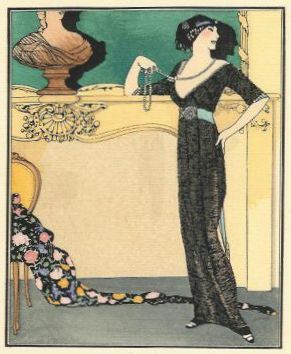
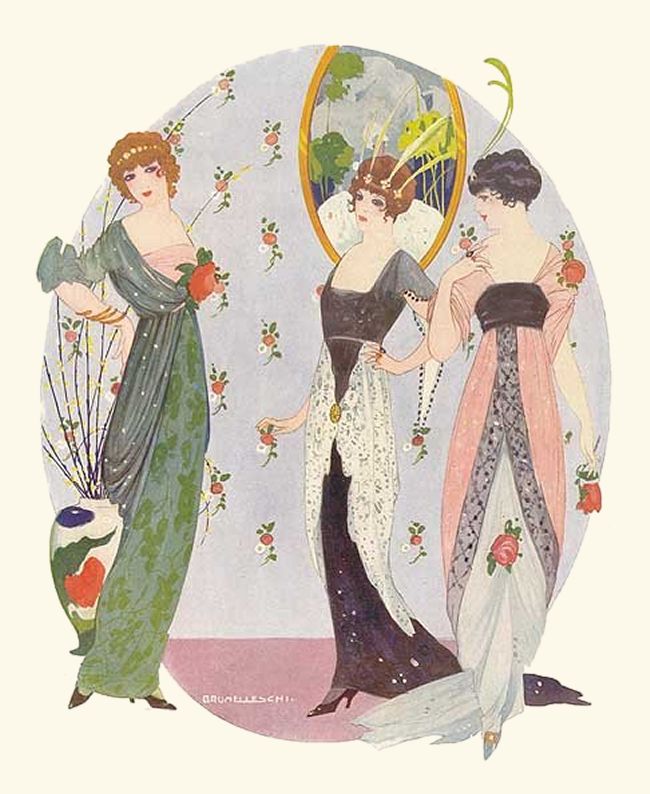
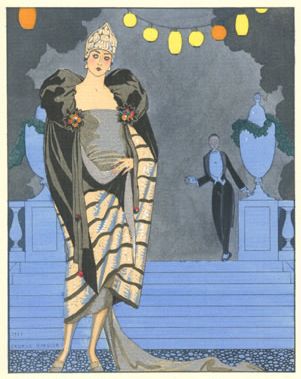
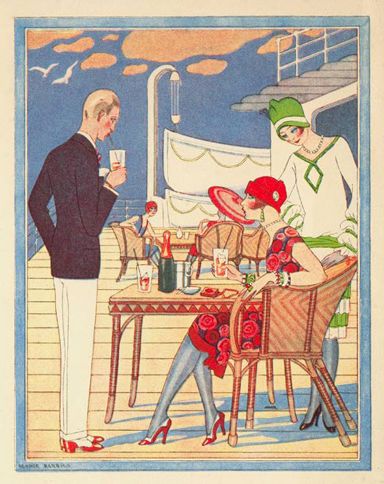
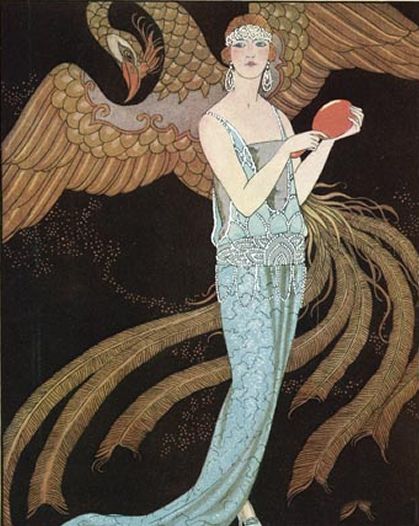
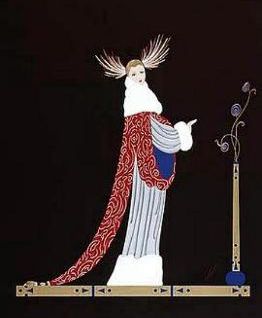


Famous French fashion journals such as Gazette du Bon Ton and Le Jardin des Dames et des Modes used the Pochoir process to produce fashion plates. Pochoir style prints were made in France from 1900 through the 1930s. Making a coloured Pochoir print is a labour-intensive hand method to using the Pochoir stencilling process. The Pochoir process has crisp lines and vibrant, brilliant colours to the point of appearing freshly wet or just printed.
A liking for Japanese prints in the c19th started this craze and it developed into a French art form employing some 600 workers in 30 design studios. These 600 workers made prints with not only fashions but patterns for interiors or fabrics, playing cards and papers.
The style is mostly associated with art nouveau and later deco styling. Metal stencils gave way to newer materials like celluloid which could be cut more easily by the Decouper. Soon watercolours were used much less in favour of thicker gouache paint. Gouache could be brushed, sprayed, stippled and textured to create a depth of colour that almost rises from the paper.
Sometimes extra watercolour would be layered atop all of this gouache to create even more interesting effects. Poiret very much liked his fashion designs to be made as a Pochoir art prints. They had a new fresh look to them and this reinforced how new and liberating his fashion styles were intended to be. George Lepape, Erte, George Barbier, Paul Iribe were all artists who are associated with illustrating in the Pochoir manner.
Trade Plates
Fashion plates are different from trade plates. Trade plates were guideline advertisements which gave ideas on how to make up the fabric products sold by a manufacturer. Examples of trade plates are shown in the 1940s section.
©Copyright Fashion-era.com 2005-2025 These images should not be reproduced in printed book form matter, as greetings cards, gift wrap etc., or as part of any electronic material such as a CD, DVD, TV videos, ebooks, websites or similar item.
Please DO NOT write to me asking for advice on your fashion plate as NONE can be given.
This Fashion Plates Page Added 8 Oct 2005, updated 07/04/2023
